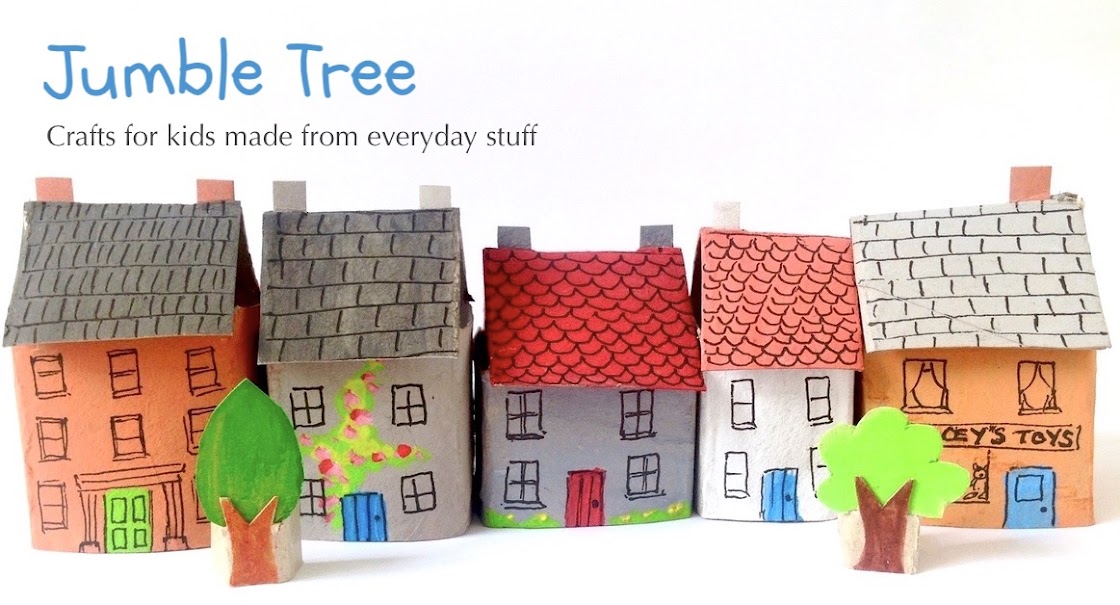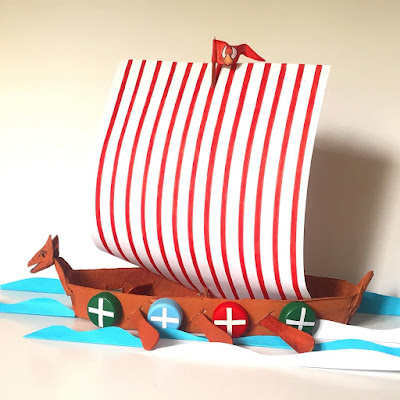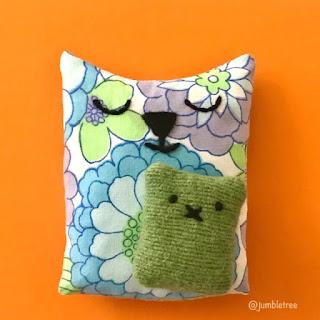These little pine cone fish have popped up before..
14.10.20
1.9.20
Egg carton Viking Longboat
This is such an easy way to make a boat - all you need is an egg carton lid, and then when you've made the basic shape, you can turn it into any kind of sailboat or ship you want.
We've gone for a Viking longboat - some Asterix influence I think! And an abundance of lollypop sticks helped too...
They do make great oars.
You will need:
A large egg carton (dozen box)
6 popsicle sticks
8 similar sized bottle tops (different colours is possible)
Sheet of plain A4 paper
Kebab stick
Some old modelling clay
Scissors
Craft glue
Strong glue (like UHU)
Paint
Red marker or felt tip pen
Black marker pen
Nail scissors (to be used by a grown up)
1. If there's paper on the lid top, remove as much of it as you can. Use a pencil to make two marks inside the lid, about 8cm/3in. from either end, and in the middle.
2. Cut out a long thinnish triangle up to your mark, at both ends.
3. You're really looking to cut away any bumpy, moulded cardboard bits that you often find at the ends of the egg carton lid (see below).
4. Next, carefully cut straight across the lid from the end of the triangle, right into the curvy edge. Do this on both sides and at both ends.
5. Then the fun bit, you simply tuck the pieces you've cut behind the central part of your boat (or in front, which ever works best), and pull the ends together, so they overlap and fit together. Trim if you want to neaten the overlap, but hopefully they should be a pretty snug fit.
You could use sticky tape, or use glue. A glue gun would be quick - we just used PVA craft glue and some clothes pegs (or paper clips) to hold it all in place while the glue dried.
6. For the raised ends of the boat, cut out an egg carton cone and neaten around the bottom edge, then cut in half, longways.
7. Flatten out the bottom part of the cut cone, and glue to the ends of the boat, so they sit high, above the boat edge. Press and mould to the curved shape of the bow and stern. Hold in place with pegs or paper clips while the glue dries.
8. For the dragon figurehead, cut out another egg carton cone and trim around the bottom edge so it's about 3cm/1in. Draw a pencil line across one side, roughly a cm from the bottom edge, then join the ends of this line to the bottom corners below, with a diagonal line. Cut along the pencil line.
9. On the longer side, draw a V from one corner to the other and cut out.
10. You can draw the details on after painting, or cut out a mouth if you prefer. This is best done by an adult with small sharp scissors.
Brush glue inside the bottom part of the figurehead and glue to one end of the boat. Leave pointing up while it dries (use a peg or paper clip again) Then bend down into place when dry.
11. For the mast, cut out an egg carton cup and neaten around the edge so it sits flat. Make a very small hole on top in the middle, and place a ball of modelling clay underneath. Press the skewer stick through the hole and into the clay. Don't glue the mast into the boat yet.
While they're drying, make the sail. Trim a piece of plain A4 paper so it's about 20cm/8in. by 25cm/10in. We drew red strips with a marker pen, but you can obviously paint or colour-in your sail anyway you like.
13. Make very small holes a few cms from the top and bottom of the sail, roughly in the middle (you don't want the holes to be too big or the sail won't stay up). When the paint is dry on the mast, slot the sail on.
14. For the flag, fold over a small piece of spare paper and cut out a long thin triangle shape. Decorate and colour in as you like, then brush glue inside and wrap around the top of the mast.
While the glue is drying, bend the flag so it looks like it's flapping in the wind.
15. For the shields, decide where you want your bottle tops to go - we put four on each side - and lightly draw around them with a pencil on the sides of the boat.
In-between these, mark diagonal lines, where the 3 oars will go on each side. Pierce through the oar lines with something like nail scissors and cut along the slots (this should be done by an adult - placing an old piece of modelling clay behind the slot helps when you're piercing through the sides.) Push the oars into place.
You can glue the mast down too, though the modelling clay will hopefully stop it from falling over. Use a black marker pen to add details to the dragon figurehead.
18.7.20
Crabby the egg carton crab
I'm a fan of these whole egg box crafts - they're simple and effective and there's space inside to store things too!
You will need:
An egg carton
Cereal box card or similar for legs, claws and eyes
Scissors
Glue
Sticky tape (optional)
White bottle tops or google eyes
Nail scissors or similar (to be used by an adult)
Black marker pen
1. Paint the top half of the egg carton orange (the lid) and some cereal box card too, for the legs, claws and eyes. You could paint the whole egg carton if you wanted to.
2. When the paint is dry, cut strips from the cereal box card - you will need 8 (...spot the mistake in the picture!) about one cm wide and 12cm long. Cut four circles too. We drew around the bottom of the paint bottle - you could use the bottom of a glass or beaker. The size of the circle will be the size of the claw, to help gauge what to use.
3. Cut a segment out of all four circles, roughly the same size. Keep two for the claws, then cut the other two in half - these will be the claw limbs. (See below)
5. Glue the claws on and make sure they face in opposite directions. Leave to dry.
6. Fold the 8 leg strips in half, then unfold them, and attach inside the carton with glue or sticky tape. Leave them to dry sticking up in the air. When dry, bend them carefully over the edge of the box. PLEASE NOTE - the BACK of the box is going to be the front of the crab.
7. THEN, press along the fold you made halfway down the strips, so it looks like a leg joint.
Push the top part of the leg up. at a bit of a angle, and bend the lower part down - to make your crab look like it's scuttling!
8. The claws go at the back of the carton, where the lid and base join. Just cut this join a little on both sides so the claw limbs can slot in more easily. Brush glue behind these cuts and along the bottom edge, and slot into place.
9. For the eyes, cut two strips from some spare painted card, about 2cm wide and 6cm long. Mark with a pencil where you want the eyes to go on top.
10. Use the nail scissors to pierce a hole through the pencil line and cut a slot (to be done by an adult). Check the strips fit.
11. Either use googly eyes or draw black circles on white bottle tops with a marker pen (we used the lids from UHT milk cartons) Glue at the end of each strip.
23. Add a smile with the marker pen and Crabby is ready!
Why not make little crabs out of egg carton cups and pipe cleaners and pop them inside?
2.7.20
Sleepy Cat with Teddy - #sewasoftie
It's something Trixi is truly passionate about, and each year she organises this worldwide Sew a Softie tutorial hop, with plenty of sewing inspiration from a gang of crafty bloggers EVERY DAY for a month.
I love hand sewing, and can still vividly remember some of the slightly strange things I made when I was little.. like a tiny green felt pony in a matchbox sized bed..
Honestly, I would still describe myself as an enthusiastic, experimental sewer, rather than a particularly accomplished one. But I do believe there's a great sense of joy and reward to be gained from diving in and having a sew, and seeing how much better you can get with a bit of practice. Something I hope I've passed onto my daughter.
Writing a tutorial with a pattern has meant I've had to think the whole process through in way more detail than I've done before, which has been an interesting learning experience!
And this tutorial does sort of fit in with my general crafty 'make do' message, as we've recently moved and I have had to make the most of what I've got here (not much..) So, very few pins! One colour of felt, no interfacing or embroidery thread.
But, if simply using what you can find around the house helps encourage a few more people to have a go, then that's got to be good thing, right?
For Sleepy cat and Teddy, you will need:
PDF pattern here
Fabric 8in.x 15in./20cmx40cm
Felt (for the tail) about 5in.x3in./13cmx8cm
Soft pencil (3b/4b/5b)
About 7in.x4in./18cmx10cm of an old wooly jumper (or piece of fabric/felt) for teddy
Pins
Needle and thread
Black (or brown) embroidery thread
OR yarn (this is what we used) and suitable needle
Button
1. Print out the PDF pattern on a sheet of A4, and cut out the three paper pieces.
Don't forget the hole where the button will go too.
4. Now, use a soft pencil and push it through the holes you've just made, pressing and twisting to make sure you mark the fabric. Remember the hole for placing the button.
OR use some black yarn (like we did), but because it'll probably be quite thick, don't double it up, just thread through and tie a knot at one end.
*KEEP CHECKING THAT YOU HAVEN'T PULLED THE STITCHES TOO TIGHT*
Hold onto the fabric and yarn where the first stitch is, and pull and gently tug the fabric and the rest of the stitches, until they lie flat and even. Make sure you do this before tying off the yarn underneath when you've finished the first eye (there's a quick video tutorial showing you how to finish off here)
Repeat for the other eye.
8. For the nose and mouth, have the paper pattern to hand.
*EASIER OPTION: For the nose, you could cut out a black felt triangle and stick in place with fabric glue.* Otherwise:
Thread the needle and knot the yarn and push the needle through the fabric from underneath, on the pencil line at point A* (have the pattern beside you so you can see the points)
Then back through at B, up through A and back through B. Then up through A* and across and back through A, to complete the triangle shape.
Again, keep checking the fabric hasn't gathered up and you haven't pulled the stitches too tight.
Now it's a case of filling in the triangle by stitching from one side to the other, passing the needle actually through, or as close to the two stitches that form either side of the triangle. Work your way down to the point.
All the time checking you haven't gathered the material by pulling the stitches too tight, and loosening them when you need to.
Again, keep checking the stitches aren't too tight. I know I keep banging on about this, but I promise it's worth the effort!
Tie off your thread underneath.
9. Sew the button on the front where the pencil mark is.
10. For the tail, use a soft pencil to draw around the template on some felt and cut it out. (If you can still see a few pencil marks just turn the tail over)
Pin to the right side of the back piece of the cat. Make sure it's about a cm or half an inch above the bottom edge.
11. Pin the two cat fabric pieces together, so the face and tail are facing inside, and the wrong sides are showing.
To help guide the seam sewing, use the soft pencil to draw a rough pencil line around the fabric shape, about a cm or so from the edge. Use the bottom of the tail as a marker for the line around the bottom of the cat.
12. Start about half way up one side - running stitch is the easiest ( double up your thread and knot the end so the thread doesn't keep slipping out of the needle). You will need to keep checking the stitches aren't too tight or too loose. Go around again if you feel the seam needs to be strengthened.
TIP: Don't make the thread too long, this will mean you'll need to tie off and re-thread as you sew around the shape, but that's less frustrating than tangles and knots..
We used back stitch (here's Trixi's video about how to seam using backstitch), which does take longer, but gives a stronger seam finish.
We used a ladder or slip stitch to close the hole, this is a little harder, but it does give a neat finish as the stitches are almost invisible. But if you prefer use overstitch
It's worth reminding kids to ask before they start chopping up jumpers.. I'm talking from experience here!
15. Fold your piece of jumper in half, pin the pattern to it and cut out. The stretchiness can make this a little tricky, but with such a simple shape it really won't matter if it's not perfect.
Finish 2cm/1in. or so from the start, turn inside out (using something to push out the corners). Add just a little stuffing before sewing the hole closed.
French knots are brilliant for eyes (Trixi has a video tutorial here)
But, if french knots are proving tricky, you could do two small stitches right next to each other for each eye instead. You'll be doing one in and out stitch with the needle, on the teddy front only, which is quite easy to do because it's stretchy. (See below)
18. Then feed the needle back towards the first eye, so it comes out just at the bottom of the eye and towards the middle for the nose/mouth (the X) Use the pattern piece as a guide.
Make a cross stitch here.
On the last stitch of the cross, take the needle through to the back of the teddy, bringing it off to a side and roughly halfway down. Make a knot here by making a little stitch, just through the surface, and thread your needle through the yarn loop before it closes. Don't pull tight until you've checked the face is okay and not stretched too tight.
Make another little stitch in line with the first one, near the other side of the teddy back. Don't tighten it until you're happy the yarn isn't too tight or too loose and, most importantly, will hook over the button on Sleepy Cat. Then, as you're pulling the thread through, pass the needle through the loop to fasten off again.
To get rid of the tail of thread, push the needle back through the teddy right next to the fastening off stitch, and out the side anywhere, pull tight, snip off the thread close to the body, and the tail should be hidden inside.
Subscribe to:
Posts (Atom)
































































